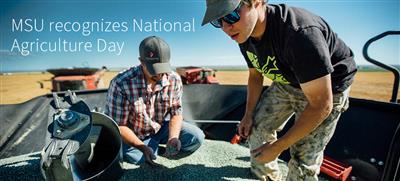By Charles Boyer, MSU Vice President of Agriculture
One hundred twenty-five years ago, the Agricultural College of the State of Montana opened its doors to the sons and daughters of Montana’s working families. Tuition was $10 a year and courses included agriculture, applied science, ladies courses, music and academy. Students could request a course catalog in writing.
That same year, 1893, the Montana Agricultural Experiment Station (MAES) was created based on the Hatch Act of 1887. This established a research enterprise dedicated to supporting Montana’s production agriculture.
What started as humble outbuildings in a newly admitted western state provided opportunity to those dedicated to reach higher through education. Today, MSU is a vibrant campus with a blend of modern buildings and historic landmarks.
One hundred twenty-five years later, much has changed, yet plenty remains the same.
The first class comprised eight students. By 1907, when Linfield Hall was built on campus, the College of Agriculture enrolled 50 students. This fall, the College of Agriculture had a record enrollment of 1,281 students, a 70 percent increase since 2007, marking a decade of enrollment growth. Like our first class, our current students have interest, passion and dedication for how we manage our natural resources, food and fiber production. We can be assured our future is in good hands. The upcoming generations will transform agriculture with innovative thinking, new technology and relationships that cross borders and accomplish what MSU’s founders once thought impossible.
In 1893 the faculty was composed of three members, including S.M. Emery, the first director of MAES. Today the college has over 125 faculty members, more than 70 of whom are supported by MAES. Collectively MAES invests over $35 million in research every year with over $18 million of these expenditures coming from faculty-led grants. The research conducted by MAES scientists spans infectious diseases in humans and animals, climate change, agricultural economics, pollination, water, livestock health, crops, and pest and disease managment. This is research that makes tangible differences in our daily lives, creates new knowledge and pushes the boundaries of scientific discoveries.
We celebrate a Montana agricultural industry as diverse as the state’s landscape. Farms and ranches are woven into the landscape and history of Montana and, by extension, MSU. This history provides a rich foundation for future success. Today our livestock, wheat, pea and lentil crops are valued the world over for their quality, creating an economic impact that exceeds $4 billion annually. We lead the nation in the production of pulse crops (peas, lentils and chickpeas). We have rich natural ecosystems shown in the recent MSU study that demonstrates Montana has the most bumblebee species in the nation. When we enjoy an artisan microbrew, the barley grown in Montana is likely to be the source for the malt used in the brewery.
March is National Agriculture Month, and we in the College of Agriculture and MAES are proud to salute our partners across the state. It is not important whether you’re a Bobcat, a Griz or a proud alumnus of another Montana campus. We all share a connection to agriculture and enjoy a diverse, abundant and healthy food system.
This spring, I challenge you to reflect with gratitude on how agriculture sustains your life and I invite you to honor those working in agriculture and those who planted the seeds for MSU and MAES 125 years ago. Thanks to this strong foundation, we look forward to our shared future. From this vantage point, nothing is impossible.
Photo by Adrian Sanchez-Gonzalez


